Mountain railways of India
The Mountain railways of India are the railway lines that were built in the mountainous regions of India. The term mainly includes the narrow-gauge railway lines in these regions but may also include some broad gauge railways.
| UNESCO World Heritage Site | |
|---|---|
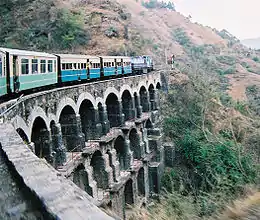 | |
| Location | India |
| Includes |
|
| Criteria | Cultural: (ii), (iv) |
| Reference | 944ter |
| Inscription | 1999 (23rd Session) |
| Extensions | 2005, 2008 |
| Area | 89 ha (0.34 sq mi) |
| Buffer zone | 645 ha (2.49 sq mi) |
Three of the narrow gauge lines, the Darjeeling Himalayan Railway, the Nilgiri Mountain Railway, and the Kalka–Shimla Railway, are collectively designated as a UNESCO World Heritage Site under the name "Mountain Railways of India". The fourth railway, the Matheran Hill Railway, is on the tentative list of UNESCO World Heritage Sites.[1] All four are narrow-gauge railways, and the Nilgiri Mountain Railway is also the only rack railway in India.
Some mountain railways such as the Lumding–Badarpur section have been converted to 1,676 mm (5 ft 6 in) broad gauge, which is the nationwide standard. Some mountain railways, such as the Jammu–Baramulla line, are currently under construction, and others are in the planning stage, such as the Srinagar–Leh line, the Bilaspur–Leh line, the Jammu–Poonch line, and the Chota Char Dham Railway. All the mountain railways constructed in recent times use broad gauge.
World Heritage Sites
Three railways, the Darjeeling Himalayan Railway, the Nilgiri Mountain Railway, and the Kalka–Shimla Railway, are collectively designated as a UNESCO World Heritage Site under the name Mountain Railways of India. The fourth railway, the Matheran Hill Railway, is on the tentative list of UNESCO World Heritage Sites.[1]
The basis of UNESCO's designation of the Mountain Railways of India as a World Heritage Site is "outstanding examples of bold, ingenious engineering solutions for the problem of establishing an effective rail link through rugged, mountainous terrain."[2] The Darjeeling Himalayan Railway received the honor first in 1999 by UNESCO followed by the Nilgiri Mountain Railway in 2005. The Kalka–Shimla Railway received the designation in 2008. The three routes together have been titled the Mountain Railways of India under UNESCO World Heritage Site criteria ii and iv, within the Asia-Pacific region. The Matheran Hill Railway, a fourth mountain line, has been nominated and is pending approval by the international body.[2][3]
Darjeeling Himalayan Railway
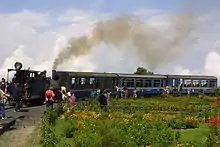
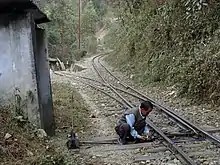
The Darjeeling Himalayan Railway, with the nickname "the Toy Train," is a 610 mm (2 ft) narrow-gauge railway that links the 88 km (55 mi) between Siliguri and Darjeeling. The latter is a major summer hill station and the centre of a flourishing tea-growing district located in West Bengal. The route is operated by Indian Railways., and its elevation starts at 100 m (330 ft) in Siliguri and rises to about 2,200 m (7,200 ft) at Darjeeling. The highest elevation is at Ghoom station, 2,300 m (7,500 ft).[4][5]
The town of Siliguri, the start of the railway route, was connected with Calcutta (now Kolkata) via railway in 1878, while the additional journey to Darjeeling required the use of tongas (horse-driven carts) along a dust track.
On the recommendations of a committee appointed by Sir Ashley Eden, work on the route began in 1879 and was completed by July 1881.[4][6] The line underwent several improvements such as making its gradients more gradual over the years to increase its manoeuvrability. By 1909–1910, the Darjeeling Himalayan Railway was carrying roughly 174,000 passengers and 47,000 tons of goods annually.[5]
Important features incorporated in the line include four loops (spirals) and four 'Z' reverses (zigzags). The introduction of bogie carriages allowed for the replacement of the basic four wheel carriages formerly used for support and stability. In 1897, a major earthquake damaged the railway, requiring rebuilding of the route, including extensive improvements to the track and stations. Further modernization occurred as part of the Northeast Frontier Railway Zone. Most trains on the route are still powered by steam engines, but a modern diesel engine is used for the Darjeeling Mail train.[4][6][7] The railway is notable for its signage located at key vantage points, marking locations with titles such as Agony Point and Sensation Corner. Another feature are spirals on steep hills that provide scenic views of the valleys below.[8]
In 1999, the Darjeeling line was the first to be recognized by UNESCO and placed on the World Heritage List. A condition of being placed upon the list was that steam locomotives would continue to be used along the route.[2]
Nilgiri Mountain Railway
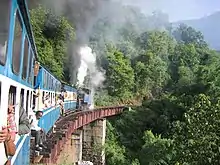
The Nilgiri Mountain Railway is a 46 km (29 mi) metre gauge single-line railway. It connects the town of Mettupalayam with the hill station of Udagamandalam (Ootacamund). The route is located within the state of Tamil Nadu and travels through the Nilgiri Hills, which are popularly known as the Blue Mountains of Southern India. The Nilgiri is the only rack railway in India, and it uses an Abt rack system. The ABT system requires the use of special steam locomotives. The line contains 208 curves, 16 tunnels, and 250 bridges, causing the uphill journey along the route to take about 290 min (4.8 h), while the downhill journey takes 215 min (3.6 h).[8][9][10]
Initially, the town of Coonoor was the final station on the line, but in September 1908 it was extended to Fernhill followed by Udagmandalam by October 15, 1908. The system was described by Guilford Lindsey Molesworth in a report from 1886:[11]
Two distinct functions – first that of traction by adhesion as in an ordinary loco; second that of traction by pinions acting on the track bars. The brakes are four in number – two handbrakes, acting by friction; and two acting by preventing the free escape of air from cylinder and thus using compressed air in retarding the progress of the engine. The former are used for shunting while the later for descending steep gradients. One of the handbrakes acts on the tyres of the wheels in the ordinary manner and the second acts on grooved surfaces of the pinion axle, but can be used in those places where the rack is laid.[11]
A unique feature of the line, which is still fully operational, is that its oldest and steepest track uses rack and pinion technology. Currently, the line runs for 7.2 km (4.5 mi), up to the foothill station of Kallar, where the rack rail portion begins. The rack rail portion ends at Coonoor railway station. The longest tunnel of this section measures 97 m (318 ft). The route has a gradient of 1:12.5 up to Coonoor, and past Coonoor to the final station the track has a ruling gradient of 1:23.[8][12]
The Nilgiri Mountain Railway was declared a UNESCO World Heritage Site in July 2005.
Kalka–Shimla Railway
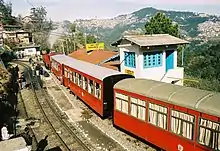
The Kalka–Shimla Railway runs between Kalka and Shimla. The railway is 95.66 km (59.44 mi) long, and its gauge is narrow 2 ft 6 in (762 mm).[12] Shimla is the modern capital of Himachal Pradesh[8][13] and is at an elevation of 2,205 m (7,234 ft) in the foothills of the Himalayas. It became the summer capital of British India in 1864, and it also served as the headquarters of the British Army in India.[8][13]
Until the railway's construction, the only access to Shimla was by village cartway. The railway line was constructed by the Delhi–Ambala–Kalka Railway Company, beginning in 1898 in the Siwalik Hills, and was completed in 1903.
The Kalka–Shimla Railway has 103 tunnels and 864 bridges. Many of the bridges are multi-arched, reminiscent of Ancient Roman aqueducts, and one bridge, which spans 18.29 m (60.0 ft), is made with plate girders and steel trusses. Its ruling gradient is 1:33 or 3%, and it features 919 curves, with the sharpest at 48 degrees (a radius of 37.47 m (122.9 ft)). The tracks climb from 656 m (2,152 ft) to a peak elevation of 2,076 m (6,811 ft) at Shimla. The longest tunnel on the line is the Barog Tunnel (No. 33), which is 1,144 m (3,753 ft) long, connecting Dagshai and Solan. The loops at Taksal, Gumman, and Dharampur help to attain flatter gradients.[8]
The Kalka–Shimla Railway joined the Nilgiri and Darjeeling lines as a World Heritage Site in 2008.[2]
Other mountain railways of India
Matheran Hill Railway
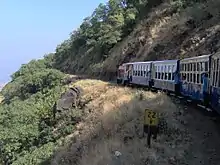
The Matheran Hill Railway is a 2 ft (610 mm) narrow-gauge railway and covers a distance of 21 km (13 mi) between Neral and Matheran, in the Western Ghats.
Its construction was led by Abdul Peerbhoy and financed by his father, Sir Adamjee Peerbhoy, of the Adamjee Group. The route was designed in 1900, with construction beginning in 1904 and completed in 1907. The original tracks were built using 30 lb/yd rails but were later updated to 42 lb/yd rails. Until the 1980s, the railway was closed during the monsoon season (because of the increased risk of landslides) but is now open all year. It is administered by Central Railways.[8]
A unique feature of the line is its horseshoe embankments. Notable features of the route include Neral Station, the first on the route; the Herdal Hill section; the steep grade of Bhekra Khud; the One Kiss Tunnel (the only tunnel on the route, which earned its nickname because the tunnel is just long enough to exchange a kiss with one's partner); a water pipe station, which is no longer in operation; Mountain Berry, which features two sharp zigzags; Panorama Point; and finally, the end of the route at Matheran Bazaar.[8] Its ruling gradient is 1:20 (5%), and its tight curves require a speed limit of 20 km/h (12 mph).
Kangra Valley Railway

The Kangra Valley Railway is 2 ft 6 in (762 mm) narrow-gauge railway and covers a distance of 163 km (101 mi) between Pathankot and Joginder Nagar, an area known for its nature and ancient Hindu shrines, in the sub-Himalayan region. The highest point on this line is at Ahju station at an elevation of 1,291 m (4,236 ft), and the terminus at Joginder Nagar is at 1,189 m (3,901 ft).[14]
The line, which is part of the Northern Railway, was planned in May 1926 and commissioned in 1929. The line has 971 uniquely designed bridges and two tunnels. Two particularly important bridge structures are the steel arch bridge over the Reond nalah and the girder bridge over the Banganga River. Though the gradient of the line is generally gentle, the critical reach with steep slopes is at the 142 km (88 mi) stretch, which is 210 m (690 ft) wide and has a slope of 1:19 and approach slopes of 1:31 and 1:25. The terminus stretch between Baijnath and Jogindernagar has a slope of 1:25.[15][8][16]
Jammu–Baramulla line
The Jammu–Baramulla line is a 1,676 mm (5 ft 6 in) railway line being built in India to connect the state of Jammu and Kashmir with the rest of the country. The railway starts from Jammu and will travel to Baramulla.
The route crosses major earthquake zones and is subjected to extreme temperatures of cold and heat, as well as inhospitable terrain, making it a challenging engineering project. The railway line has been under construction since 2002, when it was declared a national project. It will link the state's winter capital, Jammu, with the summer capital, Srinagar, and beyond until Baramulla. The railway line has been built from Jammu to Katra, and the line from Katra to Banihal may be completed by 2020.[17][18]
Proposed railways
The Srinagar–Leh line is a proposed railway line to run from Srinagar station via the town of Kargil to Leh to be operated by Indian Railways. The line was designated a national project on February 26, 2013.[19]
The Bilaspur–Leh line is a proposed railway line that is planned to connect Bilaspur in Himachal Pradesh to Leh in Ladakh region in India. The Bilaspur–Leh line is expected to become the highest railway track in the world by its completion, overtaking the current record of China's Qinghai–Tibet railway.[20]
The Jammu–Poonch line is a proposed railway line from Jammu Tawi station, via the historic city of Akhnoor, to Poonch, with stops at Kaleeth, Doori Dager, Chowki Choura, Bhambla, Nowshera and Rajouri. The line was designated a national project on March 22, 2012.[21] The newline will be 234 km (145 mi) will cost ₹7228 crore.[22]
The Chota Char Dham Railway has two different Y-shaped railways, comprising thefe our individual rail lines: the Doiwala–Dehradun–Uttarkashi–Maneri Gangotri Railway, a 131 km (81 mi) route; the Uttarkashi–Palar Yamunotri Railway, a 22 km (14 mi) route with "Y" fork connection at Uttarkashi from the Gangotri railway above; the Karnaprayag–Saikot–Sonprayag Kedarnath Railway, a 99 km (60 mi) route; and Saikot–Joshimath Badrinath Railway, a 75 km (45 mi) with "Y" fork connection at Saikot from the Kedarnath railway above. The Rishikesh–Karnaprayag Railway, also an under construction, is a new railway link extension from the exiting Rishikesh railway station to Karnaprayag of the above system.[23]
The Sivok–Rangpo line is a proposed railway line planned to connect the towns of Sevoke in West Bengal and Rangpo in Sikkim and also link Sikkim with the Indian Railway network. It is planned to be extended to Gangtok and the India-China border in the future.[24]
See also
- Mountain railway
References
Notes
- Centre, UNESCO World Heritage. "Mountain Railways of India". whc.unesco.org. Archived from the original on 2006-05-03. Retrieved 2017-06-08.
- "Mountain Railways of India". World Heritage:UNESCO. Archived from the original on 2006-05-03. Retrieved 2010-02-19.
- Srinivasan, Rupa; Manish Tiwari; Sandeep Silas (2006). Our Indian Railway: themes in India's Railway history. Foundation Books. pp. xxxiv–xxxv. ISBN 81-7596-330-1. Retrieved 2010-02-21.
- Whittle, Paul; Terry Martin. "A Brief History of the DHR". History and A Trip Up the Line. Darjeeling Himalayan Railway Society. Retrieved 2007-02-24.
- "History of Darjeeling Himalayan Railway". Archived from the original on 2011-07-17. Retrieved 2010-04-03.
- "DHr History". Darjeeling.net. Archived from the original on 2003-12-13. Retrieved 2010-02-19.
- "The Loop, Agony Point, Darjeeling [Hill Railway]". British Library Online Gallery. Archived from the original on 2011-06-04. Retrieved 2010-02-21.
- Kohli, M.S.; Ashwani Lohani (2004). Mountains of India: Tourism, Adventure, Pilgrimage. The Indian Mountain Railway. Indus Publishing. pp. 97–106. ISBN 81-7387-135-3. Archived from the original on 2021-05-08. Retrieved 2010-02-20.
- Krishnan, Govind. V.M. NMR Nilgiri Mountain Railway:From Life Line to Oblivion. krishnantech.net. Archived from the original on 2018-11-07. Retrieved 2010-02-21.
- "Cultural Sites inscribed on UNESCO's World heritage List". India-Mountains railways of India. World Heritage List;UNESCO. 2005-06-15. Archived from the original on 2006-08-13. Retrieved 2019-12-26.
- Kholi p.104
- "Mountain Railways of India – Chugging and romancing the hills". Northern Voices Online. Retrieved 2017-03-20.
- "HP declares Kalka–Shimla railway as 'heritage' property". The Hindu. 2010-02-21. Archived from the original on 2008-09-27. Retrieved 2010-02-19.
- "Trains to Ahju Station – 4 Arrivals NR/Northern Zone – Railway Enquiry". indiarailinfo.com. Archived from the original on 2019-04-19. Retrieved 2019-02-22.
- Abram, David (2003). Rough guide to India. Rough Guides. p. 479. ISBN 1-84353-089-9. Retrieved 2010-02-20.
- "Luxury Trains of India". Archived from the original on January 3, 2004. Retrieved 2010-02-20.
{{cite web}}: CS1 maint: unfit URL (link) - "Kashmir Rail Link to be Completed by 2020. Will Have World's Highest Railway Bridge". NDTV.com. 4 July 2015. Archived from the original on 24 August 2019. Retrieved 24 July 2017.
- "Kashmir rail link project to be completed by 2030: Railway officials". The Times of India. Archived from the original on 2019-09-07. Retrieved 2017-07-24.
- "Archived copy". Archived from the original on 2013-07-16. Retrieved 2013-05-13.
{{cite web}}: CS1 maint: archived copy as title (link) - "When men defies his limits: Living in the altitude : Articles". SummitPost. Archived from the original on 2013-09-03. Retrieved 2012-04-02.
- "Archived copy". Archived from the original on 2013-07-28. Retrieved 2012-03-27.
{{cite web}}: CS1 maint: archived copy as title (link) - "Jammu-Poonch railway line to cost Rs. 7227 crore: Govt". Archived from the original on 2018-11-08. Retrieved 2017-07-25.
- "Coming soon: India's longest railway tunnel on Rishikesh-Karnprayag route". Hindustan Times. September 19, 2016. Archived from the original on July 10, 2021. Retrieved July 10, 2021.
- "Sivok-Rangpo railway: Soon, travel from Bengal to Sikkim in 2 hrs". East Mojo. East Mojo. 21 September 2019. Archived from the original on 19 August 2020. Retrieved 18 January 2020.
Bibliography
- Wallace, Richard (2021). Hill Railways of the Indian Subcontinent. Ramsbury, Marlborough, UK: The Crowood Press. ISBN 9781785008085.

